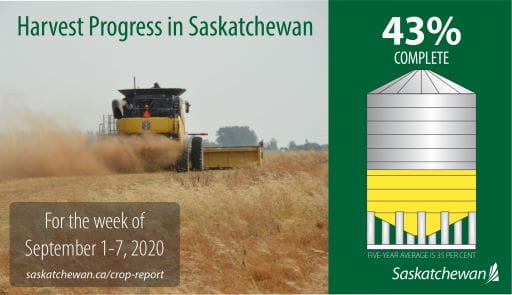Released on September 10, 2020
Producers made significant harvest progress this week with 43 per cent of the crop now in the bin, up from 28 per cent last week and remaining well ahead of the five-year (2015-2019) average of 35 per cent for this time of year. An additional 29 per cent of the crop is swathed or ready to straight-cut. While rain in some eastern and northern areas delayed harvest progress, the majority of the province continued harvest operations this week.
The southwest region continues to have the most progress in the province with 71 per cent of the crop now combined. The southeast region has 59 per cent combined, the west-central 38 per cent, the east-central 29 per cent, the northeast 17 per cent and the northwest seven per cent.
Ninety-one per cent of lentils, 87 per cent of field peas, 73 per cent of mustard, 58 per cent of barley, 62 per cent of durum, 39 per cent of chickpeas, 32 per cent of spring wheat and 23 per cent of canola has now been combined. An additional 49 per cent of canola is swathed or ready to straight-cut.

Estimated average crop yields at this time are 45 bushels per acre for hard red spring wheat, 38 bushels per acre for durum, 67 bushels per acre for barley, 35 bushels per acre for canola, 39 bushels per acre for field peas and 1,548 pounds per acre for lentils. There are indications that the heat a few weeks ago has caused more damage in some crops than first anticipated.
Rainfall last week ranged from small amounts to 29 mm in the Kelvington area. Provincial topsoil moisture conditions continue to deteriorate with recent strong winds. Cropland topsoil moisture is rated as two per cent surplus, 34 per cent adequate, 41 per cent short and 23 per cent very short. Hay and pasture land topsoil moisture is rated as one per cent surplus, 23 per cent adequate, 42 per cent short and 34 per cent very short.
The majority of crop damage this past was due to strong winds, lack of moisture and frost. Most of the province received a hard frost earlier this week that caused damage to later-seeded and immature crops. Producers are assessing the damage to determine the potential impact. As field conditions remain very dry in some areas, seeding of winter cereals will be minimal this fall. Strong winds continue to blow swaths and shell standing crops.
Farmers are busy combining, swathing, baling straw and hauling bales.
With harvest underway in Saskatchewan, we want to remind producers to exercise caution and remain safe.
A complete, printable version of the Crop Report is available online at https://www.saskatchewan.ca/crop-report.
Follow the 2020 Crop Report on Twitter at @SKAgriculture.
-30-
For more information, contact:
Shannon Friesen
Agriculture
Moose Jaw
Phone: 306-694-3592
Email: shannon.friesen@gov.sk.ca

